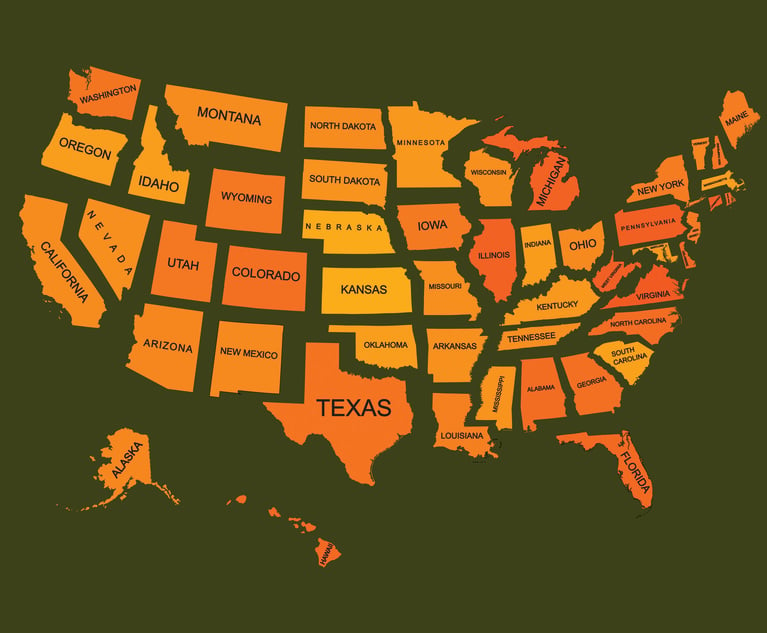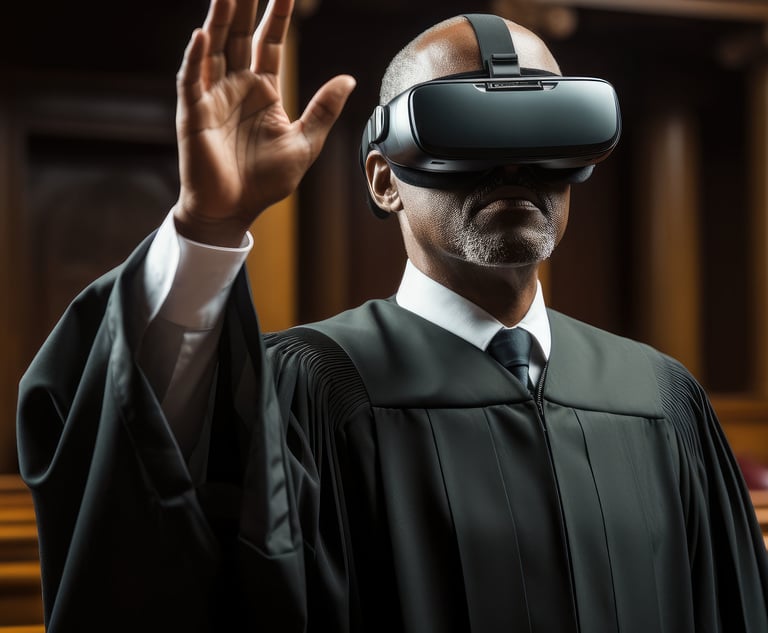How Tech Is Helping Fuel the Rise of the Mid-Market
The fact that the mid-market is increasingly turning heads can be attributed to a wide range of factors. A number of them, though, can be traced back—directly or indirectly—to technology.
March 08, 2024 at 01:10 PM
7 minute read
Each week, the Law.com Barometer newsletter, powered by the ALM Global Newsroom and Legalweek brings you the trends, disruptions, and shifts our reporters and editors are tracking through coverage spanning every beat and region across the ALM Global Newsroom. The micro-topic coverage will not only help you navigate the changing legal landscape but also prepare you to discuss these shifts with thousands of legal leaders at Legalweek 2025, taking place from March 24-27, 2025, in New York City. Registration will be opening soon.
The Disruption: How Tech Is Helping Fuel the Rise of the Mid-Market
Since 2022, the demand for the quality and value midsize law firms can provide has been on the rise. Now, in 2024, firms whose names would once never have been uttered in the same conversation as their Big Law counterparts are establishing themselves as forces to be reckoned with.
The fact that the mid-market is increasingly turning heads can be attributed to a wide range of factors. A number of them, though, can be traced back—directly or indirectly—to technology. From the meteoric rise of generative AI and its attendant ability to empower firms to handle large matters with smaller teams, to attorneys' growing preference for a quality of life that only tech-powered flexibility can offer, technology is leveling the law firm playing field to a degree not previously seen.
The Conversation
For midsize firms to make a viable run at Big Law, they had to find a way to meaningfully compete—namely, by solving the ever-elusive "do more with less" riddle and handling the same caliber of work as large firms, but with a fraction of the resources. Historically, the problem seemed unsolvable. While technology has offered the possibility to make inroads for a while now, many firms didn't realize its full potential. Then generative AI came along.
While lawyers at large firms were suddenly, if wrongly, panicking that AI would eliminate their jobs overnight, midsize firms didn't have that problem, because they didn't have lawyers to spare. Instead, generative AI presented the possibility of exponentially expanding the capacity of the small workforces they had, allowing them to take on more, and more complex, work without increasing headcount. Such increased capacity could open the door to a caliber of clients that was once well out of their reach.
Additionally, implementing new generative AI tools, or even overhauling entire systems, was theoretically a less daunting prospect for midsize firms than large firms with massive infrastructures—imagine if changing a tech stack was like steering a motor boat rather than trying to turn a cruise ship. Of course, the theoretical ease of adoption was counterbalanced for many smaller firms by the high price tags that came with generative AI. But those who could find a way to fund the upfront investment are now positioning themselves as powerful competitors in the market and set to reap the rewards for years to come.
Of course, generative AI isn't the only catalyst in play. Midsize firms are increasingly unlocking the power of other modern technologies at lower price points that are helping them to punch above their weight class. It doesn't take the shiniest bells and loudest whistles to have systems in place that allow a mid-market firm to land Big Law-caliber work and clients. A large part of the equation involves flexible, efficient tools that foster security, increased productivity and efficiency, and personalized client service—and that doesn't necessarily mean generative AI. Often it might mean automation, cloud computing, or "traditional" AI, which are far more affordable than the current, buzzy generative AI tools, and put capabilities that once were the sole purview of Big Law squarely in the hands of midsize firms.
It's also important to remember that the mid-market started making notable strides before the generative AI boom (ChatGPT wasn't released to the public until Nov. 30, 2022). It's no coincidence that this came on the heels of the pandemic-driven focus on technology. Firms of all sizes implemented new technologies and leaned into the capabilities of the tools they already had. Workers discovered new abilities to be productive any time, anywhere.
And given their increased agility and flexibility as compared to their larger counterparts, midsize firms were in the best position to benefit from these new, technological, post-pandemic realities of practicing law.
The Significance
While we may not yet be at a full David vs. Goliath final battle, Big Law should start viewing their mid-market counterparts as viable competitors, if they're not already.
The more midsize firms explore generative AI and other technologies and realize the tangible benefits—and not just hype—they bring, the more they'll start to implement them, and the more competitive they'll become. And it's not just the clients who are noticing. Tech-enabled midsize firms are positioning themselves as attractive employers for top talent as well.
In decades past, the move from Big Law to midsize firms often meant choosing between quality of work or quality of life. Now, midsize firms are competing for complex cases and major clients, while also offering the same quality of life they were always known for, if not better. Big Law, on the other hand, is still stuck on one side of the equation. They offer the quality of work—a pie that the mid-market is consistently eating into—but they're not coming around on the quality of life.
If anything, many are obstinately swimming upstream against it. The pandemic brought with it remote work, and, as it turns out, a lot of attorneys liked it. Now, law firms are implementing ever-stricter return to office policies, continually increasing the required number of in-office days, despite the demonstrated effectiveness of technology and remote work during the pandemic. And they're doing it in the face of survey after survey that shows that associates detest firms that prioritize profits over people, are unhappy with return to office policies, and would leave their jobs for better work-life balance.
The time for midsize firms to make a play for these unhappy yet talented associates is now, when they can offer the perfect storm of top work and ideal lifestyle, both enabled by technology.
The Information
Want to know more? Here's what we've discovered in the ALM Global Newsroom:
- Midsize Firms Punch Above Their Weight to Win Big Clients
- Generative AI Slated to Shake Up Competition in Big, Midsize Law Market
- Technology Is the Great Equalizer in a Hybrid Workforce
- AI Dominates While Midsize Firms Gain Steam: Takeaways from ABA Techshow 2024
- Mid-Market Roundup: Where to Look for Industry Growth
- 'Cautious But Optimistic': After Slow Adoption, Midsize Firms See Vast Potential For Gen AI
- The New Normal in Office Work Is Here, but Lawyers Still Aren't Happy With It
- A 'Sweatshop'? Lawyers Detest Law Firm Cultures That Emphasize Profitability
- Big Law's Return-to-Office Journey Still Not Complete, but More Settled Now
The Forecast
The mid-market will likely be seen as even more of a competitive threat in the coming year and beyond. As generative AI tools become more widespread, and as the prices of those tools come down, the capacity of these firms to do more with less staff and fewer resources, and to court top clients, will only increase, allowing them to gain even more of a competitive advantage against their Big Law counterparts.
As the mid-market strengthens, more Big Law talent who only previously considered jumping ship will start to turn thought into action, unless their employers make a concerted effort to retain them. While a few firms have started to decrease office size in favor of more modern, flexible work environments, plenty of firms are holding steady on a course set for traditional offices with five-day, in-office work weeks, relying on pedigree to attract talent, as it long has. If they refuse to deviate and consider new paths, they risk losing attorneys who want more modern careers.
David may not win the battle this year, but technology has opened the doors to Goliath's arena.
 Stephanie Wilkins is the Editor-in-Chief of Legal Technology and Legaltech News at ALM. Contact her at [email protected] and follow her on LinkedIn.
Stephanie Wilkins is the Editor-in-Chief of Legal Technology and Legaltech News at ALM. Contact her at [email protected] and follow her on LinkedIn.
This content has been archived. It is available through our partners, LexisNexis® and Bloomberg Law.
To view this content, please continue to their sites.
Not a Lexis Subscriber?
Subscribe Now
Not a Bloomberg Law Subscriber?
Subscribe Now
NOT FOR REPRINT
© 2025 ALM Global, LLC, All Rights Reserved. Request academic re-use from www.copyright.com. All other uses, submit a request to [email protected]. For more information visit Asset & Logo Licensing.
You Might Like
View All
The Week in Data Dec. 13: A Look at Legal Industry Trends by the Numbers
Trending Stories
- 1'It's Not Going to Be Pretty': PayPal, Capital One Face Novel Class Actions Over 'Poaching' Commissions Owed Influencers
- 211th Circuit Rejects Trump's Emergency Request as DOJ Prepares to Release Special Counsel's Final Report
- 3Supreme Court Takes Up Challenge to ACA Task Force
- 4'Tragedy of Unspeakable Proportions:' Could Edison, DWP, Face Lawsuits Over LA Wildfires?
- 5Meta Pulls Plug on DEI Programs
Who Got The Work
Michael G. Bongiorno, Andrew Scott Dulberg and Elizabeth E. Driscoll from Wilmer Cutler Pickering Hale and Dorr have stepped in to represent Symbotic Inc., an A.I.-enabled technology platform that focuses on increasing supply chain efficiency, and other defendants in a pending shareholder derivative lawsuit. The case, filed Oct. 2 in Massachusetts District Court by the Brown Law Firm on behalf of Stephen Austen, accuses certain officers and directors of misleading investors in regard to Symbotic's potential for margin growth by failing to disclose that the company was not equipped to timely deploy its systems or manage expenses through project delays. The case, assigned to U.S. District Judge Nathaniel M. Gorton, is 1:24-cv-12522, Austen v. Cohen et al.
Who Got The Work
Edmund Polubinski and Marie Killmond of Davis Polk & Wardwell have entered appearances for data platform software development company MongoDB and other defendants in a pending shareholder derivative lawsuit. The action, filed Oct. 7 in New York Southern District Court by the Brown Law Firm, accuses the company's directors and/or officers of falsely expressing confidence in the company’s restructuring of its sales incentive plan and downplaying the severity of decreases in its upfront commitments. The case is 1:24-cv-07594, Roy v. Ittycheria et al.
Who Got The Work
Amy O. Bruchs and Kurt F. Ellison of Michael Best & Friedrich have entered appearances for Epic Systems Corp. in a pending employment discrimination lawsuit. The suit was filed Sept. 7 in Wisconsin Western District Court by Levine Eisberner LLC and Siri & Glimstad on behalf of a project manager who claims that he was wrongfully terminated after applying for a religious exemption to the defendant's COVID-19 vaccine mandate. The case, assigned to U.S. Magistrate Judge Anita Marie Boor, is 3:24-cv-00630, Secker, Nathan v. Epic Systems Corporation.
Who Got The Work
David X. Sullivan, Thomas J. Finn and Gregory A. Hall from McCarter & English have entered appearances for Sunrun Installation Services in a pending civil rights lawsuit. The complaint was filed Sept. 4 in Connecticut District Court by attorney Robert M. Berke on behalf of former employee George Edward Steins, who was arrested and charged with employing an unregistered home improvement salesperson. The complaint alleges that had Sunrun informed the Connecticut Department of Consumer Protection that the plaintiff's employment had ended in 2017 and that he no longer held Sunrun's home improvement contractor license, he would not have been hit with charges, which were dismissed in May 2024. The case, assigned to U.S. District Judge Jeffrey A. Meyer, is 3:24-cv-01423, Steins v. Sunrun, Inc. et al.
Who Got The Work
Greenberg Traurig shareholder Joshua L. Raskin has entered an appearance for boohoo.com UK Ltd. in a pending patent infringement lawsuit. The suit, filed Sept. 3 in Texas Eastern District Court by Rozier Hardt McDonough on behalf of Alto Dynamics, asserts five patents related to an online shopping platform. The case, assigned to U.S. District Judge Rodney Gilstrap, is 2:24-cv-00719, Alto Dynamics, LLC v. boohoo.com UK Limited.
Featured Firms
Law Offices of Gary Martin Hays & Associates, P.C.
(470) 294-1674
Law Offices of Mark E. Salomone
(857) 444-6468
Smith & Hassler
(713) 739-1250












